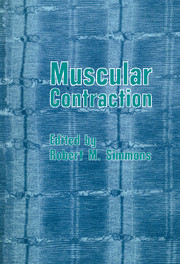Book contents
- Frontmatter
- Contents
- Dedication
- Contributors
- Preface
- 1 A. F. Huxley: an essay on his personality and his work on nerve physiology
- 2 A. F. Huxley's research on muscle
- 3 Ultraslow, slow, intermediate, and fast inactivation of human sodium channels
- 4 The structure of the triad: local stimulation experiments then and now
- 5 The calcium-induced calcium release mechanism in skeletal muscle and its modification by drugs
- 6 Hypodynamic tension changes in the frog heart
- 7 Regulation of contractile proteins in heart muscle
- 8 Differential activation of myofibrils during fatigue in twitch skeletal muscle fibres of the frog
- 9 High-speed digital imaging microscopy of isolated muscle cells
- 10 Inotropic mechanism of myocardium
- 11 Regulation of muscle contraction: dual role of calcium and cross-bridges.
- 12 Fibre types in Xenopus muscle and their functional properties.
- 13 An electron microscopist's role in experiments on isolated muscle fibres.
- 14 Structural changes accompanying mechanical events in muscle contraction.
- 15 Mechano-chemistry of negatively strained cross-bridges in skeletal muscle.
- 16 Force response in steady lengthening of active single muscle fibres.
- References
- Index
10 - Inotropic mechanism of myocardium
Published online by Cambridge University Press: 07 September 2010
- Frontmatter
- Contents
- Dedication
- Contributors
- Preface
- 1 A. F. Huxley: an essay on his personality and his work on nerve physiology
- 2 A. F. Huxley's research on muscle
- 3 Ultraslow, slow, intermediate, and fast inactivation of human sodium channels
- 4 The structure of the triad: local stimulation experiments then and now
- 5 The calcium-induced calcium release mechanism in skeletal muscle and its modification by drugs
- 6 Hypodynamic tension changes in the frog heart
- 7 Regulation of contractile proteins in heart muscle
- 8 Differential activation of myofibrils during fatigue in twitch skeletal muscle fibres of the frog
- 9 High-speed digital imaging microscopy of isolated muscle cells
- 10 Inotropic mechanism of myocardium
- 11 Regulation of muscle contraction: dual role of calcium and cross-bridges.
- 12 Fibre types in Xenopus muscle and their functional properties.
- 13 An electron microscopist's role in experiments on isolated muscle fibres.
- 14 Structural changes accompanying mechanical events in muscle contraction.
- 15 Mechano-chemistry of negatively strained cross-bridges in skeletal muscle.
- 16 Force response in steady lengthening of active single muscle fibres.
- References
- Index
Summary
Introduction
One of our main goals of my laboratory has been to learn how the heart varies the strength of its contraction in response to inotropic stimuli. Although Sir Andrew has never worked in this area directly, he has had a substantial influence here, in part because of his elucidation of contractile mechanisms and in part because of the training he has provided to workers in this field. In my own case his influence was enormous, and the experiments I shall be describing would have been impossible without the fast servo systems I learned to use in his laboratory during the three years I spent there from 1971 to 1974.
It is now well established that the contractile elements of striated muscle become activated when calcium is released into the myofilament space from the sarcoplasmic reticulum, where it is stored during diastole. One way of regulating the strength of the heartbeat, therefore, is to regulate the amount of calcium released with each beat.
A second way of regulating the strength of contraction is to alter the fraction of the released calcium that binds to the myofilaments. The binding of calcium to cardiac myofilaments is altered by well-established second-messenger systems in response to inotropic stimuli (see review by Winegrad, 1984). Taken together, the two mechanisms described so far can be classified as regulating the amount of calcium activation. A final way of regulating the strength of contraction is to alter the contractile process itself. This is the mechanism on which we have recently focussed our attention.
- Type
- Chapter
- Information
- Muscular Contraction , pp. 147 - 162Publisher: Cambridge University PressPrint publication year: 1992



